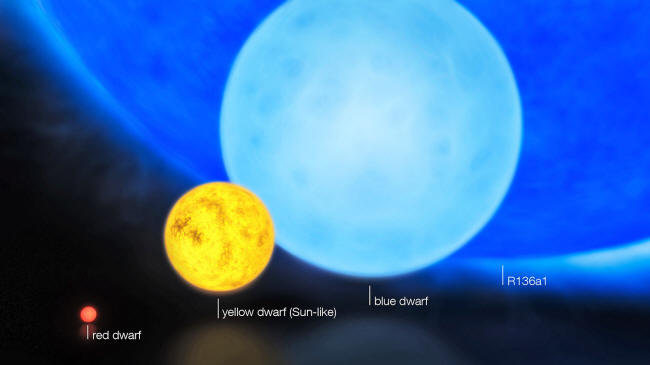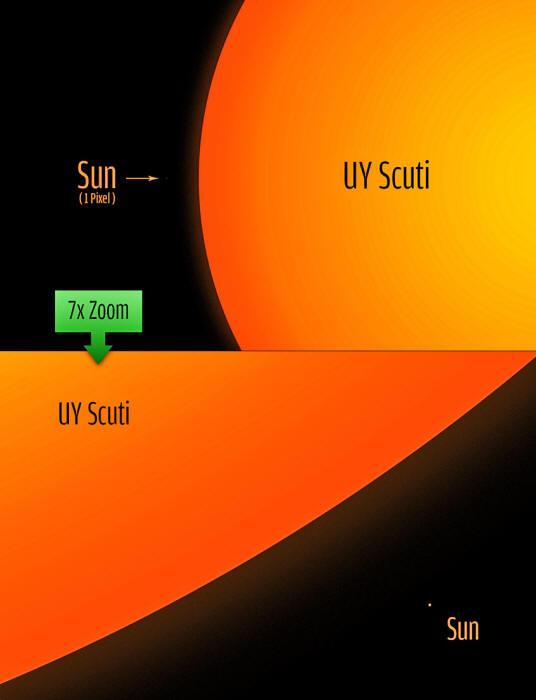|
by Nola Taylor Redd shows the relative sizes of young stars, from the smallest red dwarfs, weighing in at about 0.1 solar masses, through low-mass yellow dwarfs, such as the sun, to massive blue dwarf stars weighing eight times more than the sun,
as well
as the 300-solar-mass star named R136a1.
About half of all known stars are more massive; about half have less mass.
At the top end of the scale, the most massive known star in the sky is R136a1, a star more than 300 times as massive as our sun. And it's not alone in dwarfing Earth's dominant star.
This massive star lies
outside our galaxy; it's part of the
Large Magellanic Cloud, one of the
Milky Way's satellite galaxies.
(Its mass when discovered was estimated at 265 solar masses, but further observations in 2016 with NASA's Hubble Space Telescope refined the original measurements - The R136 star cluster dissected with Hubble Space Telescope/STIS.)
Although this makes it the most massive known star, it was once even larger.
Although R136a1 is the most massive known star, it is not the largest, since it only stretches about 30 times the radius of our sun.
An illustration of the approximate size of UY Scuti compared to the Sun
The largest known star is
UY Scuti, a hypergiant with a
radius somewhere around 1,700 times larger than the sun. Its mass,
however, is only 30 times that of our nearest star.
Its powerful radiation would have serious consequences for Earth.
While stars like the sun are made up predominantly of hydrogen and helium, Wolf-Rayet stars carry high amounts of other heavy elements.
Massive stars like R136a1 can have profound effects on their environment.
Their high radiation
pressures are thought to drive powerful stellar winds. The winds can
distribute about 10 solar masses of material per million years at
speeds of up to 1,864 miles (3,000 kilometers) per second.
Scientists know of just over 200 Wolf-Rayet stars in the galaxy, but the Milky Way is estimated to contain as many as 2,000 of them, most of them hidden by dust.
Roughly half of Wolf-Rayet
stars are thought to have companions, either another massive star, a
black hole or a neutron star.
While the universe
started out filled with hydrogen and helium, stars are the factories
that churn those light elements into almost every other element.
When massive stars die an explosive death, they blow that material
off, where it is gathered by other stars and formed into planets.
Collisions between neutron stars are thought to be one source of gravitational waves.
A 2018 study of the Tarantula Nebula, also called 30 Doradus or 30 Dor, revealed that R136a1 is not alone; the nebula hosts several other stars with the greatest masses yet detected.
While hunting for stars more than 30 solar masses in size, researchers found a wealth of much larger stars.
Fabien Schneider and his colleagues used the European Southern Observatory's Very Large Telescope (VLT) in Chile to analyze the masses and ages of about 800 massive stars in the Tarantula Nebula.
They found about 30 percent more stars with masses more than 30 times that of the sun than they expected, and about 70 percent more than expected above 60 solar masses.
But in light of the new study,
Some of the other most massive stars include:
All of these stars lie in
the Tarantula Nebula in the Large Magellanic Cloud.
However, the Milky Way has its own contenders.
The enormous star orbits
the galaxy in its Perseus Arm in the open cluster IC 1805, which
lies in the constellation of Cassiopeia.
Like R136a1, NGC 3603-B is a Wolf-Rayet star. It is part of the star-forming region NGC 3603, which orbits in the Carina spiral arm of the Milky Way.
|



